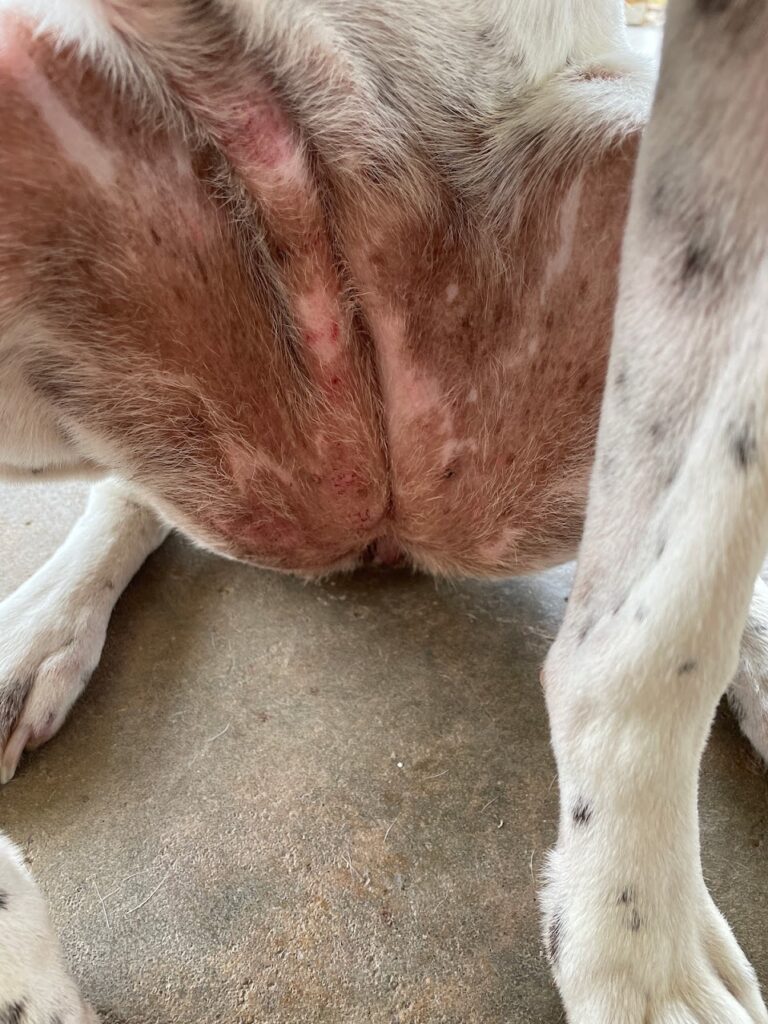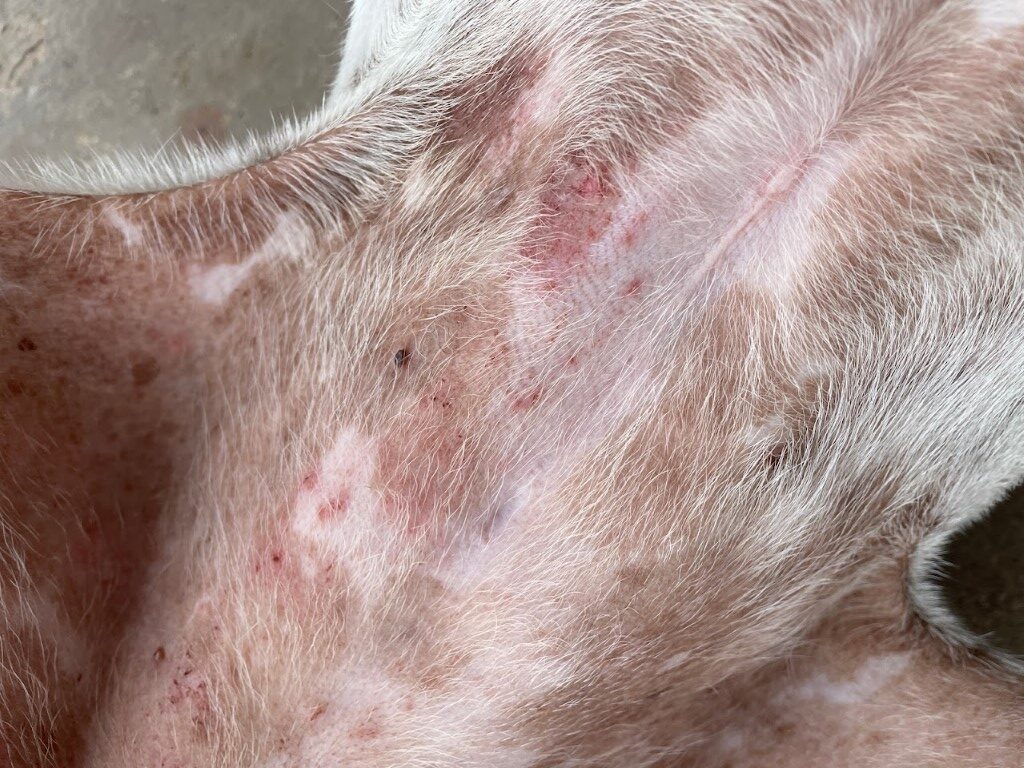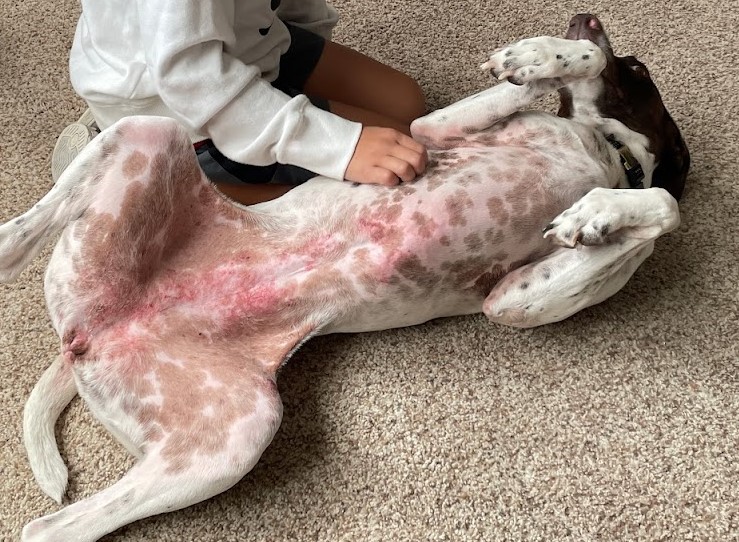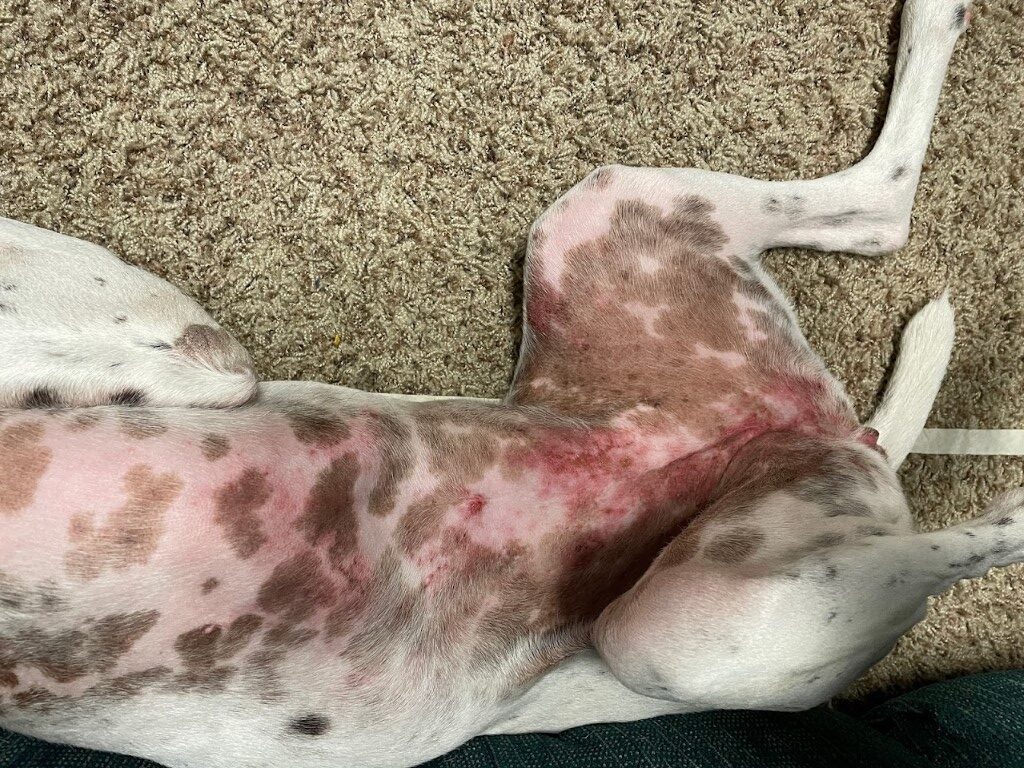Affiliate Disclosure: This post may contain affiliate links. If you buy through them, I may earn a commission at no extra cost to you. For more information please refer to the Disclaimer, Terms and Conditions, and Privacy Policy.
In this post, you will learn all about Lupus in Dogs and my German Shorthaired Pointer’s Lupus diagnosis

Lupus In Dogs
Did you know dogs can have lupus? I was shocked to find out that my dog had lupus, as this was just something that I had never really heard about. I’ve spoken with many other people, and all of them were as shocked as I was to learn that dogs can have lupus. So, I wanted to share my story, from my German Shorthaired Pointer’s onset of symptoms to her full treatment program. If you suspect your dog may have lupus, see your veterinarian.
So, let’s get started with my dog’s lupus journey from the beginning.
*Disclaimer: The content provided in this blog post is based solely on my personal experience with my dog’s lupus diagnosis and treatment plan. It is not intended to be a substitute for professional medical advice, diagnosis, or treatment. Always seek the advice of your veterinarian with any questions you may have regarding your pet’s medical condition.
Meet My German Shorthaired Pointer
My German Shorthaired Pointer is a female, and she has been in extremely good health her whole life. She is wild, hyper, playful, and kind. She loves playing in the sprinklers and chewing on old water bottles. Her favorite thing to do is hunt rabbits in the backyard. She never catches the rabbits, but she’ll stay on point stalking one for an hour if that’s what it takes! You can learn more about her in this post: 20 Things You NEED to know about German Shorthaired Pointers. Overall, she had been a very healthy dog, with absolutely no medical issues, to date.
My beautiful German Shorthaired Pointer ❤

Onset of Symptoms: Dog with Rash on Belly
Her first symptoms started in August of 2022 when she was 6 years old. We initially discovered she had a rash on her belly. There were small red dots and sores, and the overall color of her belly was more red than normal. She was also licking a lot, and she had eye discharge. The rash developed and worsened rapidly. Luckily, my dog didn’t seem to be in much pain with it and was still eating, drinking, and acting totally normal. She did lick and scratch a lot, though. Since we didn’t see any improvement in the rash, we took her to the vet 2 days after it appeared. Here are a few photos of my dog’s rash the first time it appeared.

rash on dog’s belly

photo of belly rash on dog
The vet examined her and said that her tummy looked “mad” and that she looked like she was having some kind of reaction. We went through many questions about anything that may have changed in her environment, but we didn’t have any good leads. The vet told me it could be an environmental factor, a new allergy, or an autoimmune disorder. She was leaning more toward an allergy or something that she may have come in contact with. So, the treatment at this time was a prednisone shot, which the vet said should last for around a month. By the next day, the rash and all her symptoms were totally cleared up. We hoped this was simply a reaction to something she came in contact with and this would be the end of it.
Second Outbreak – Rash Returned on Dog’s Belly
Unfortunately, things did not turn out how we hoped. Almost one month later (to date), she had another outbreak, and this time, it got a lot worse. The rash came on so quickly! It started as one small spot and, within a day, covered her entire belly. This rash had spots that were really sore and oozing. She also had red eyes and lots of eye discharge. She was still eating and drinking fine but did develop a strange cough (maybe reverse coughing). She licked and scratched, but otherwise acted normal and didn’t appear to be in pain. Here are some photos of how she looked during her second outbreak.

The rash is covering her entire belly and her skin is very red.

In some spots the rash is oozing and scabbing

A close-up view of the rash shows some of the spots that are oozing.
So, as you can see from the photos, this rash was worse than the first. When I noticed the rash might be coming back, I researched to try to determine what ma,y be causing it. I was really hoping it was something she was coming into contact with, so I scoured my backyard. I did find a plant that I thought might be the cause, but not much else. I went ahead and scheduled an appointment with my vet.
During this visit, the vet and I sat down and discussed everything. She was very reluctant to give her another prednisone shot because she had had one so recently. It was important that we determine the “cause” of the rash, as we cannot just keep doing prednisone shots. I told her I found a plant in the backyard that I thought could be the cause. Ultimately, she decided to go ahead with the prednisone shot one last time, since the rash was so severe. She made it very clear that we would not be doing another prednisone shot, and if the rash came back, we would need to do a biopsy to see if it might be lupus or an autoimmune disorder causing it. The vet also recommended we remove all corn-based foods from her diet because some dogs develop a corn allergy over time. She recommended we switch to Diamond Naturals dog food.
In summary, the following potential causes were discussed:
- Food or Environmental Allergy – Change dog food to Diamond Naturals.
- Contact with an Irritant – Remove potential plant in the backyard.
- Autoimmune Disorder – Lupus – Plan to do biopsy if rash recurs.
Again, the prednisone shot cleared everything up very rapidly. I followed the vet’s orders and got her switched over to the recommended new corn-free dog food. Here is the dog food that we switched to: Diamond Naturals – Adult – Beef Meal & Rice. I also removed any trace of the suspicious plant in the backyard.
In the meantime, I spent time researching autoimmune disorders in dogs. When I searched for similar rash photos, I continued to find “exfoliative cutaneous lupus erythematosus.” This is a disease that only affects German Shorthaired Pointers and is fatal. Here is an article that explains this disease in more detail. Exfoliative cutaneous lupus erythematosus. Thankfully, I was able to rule that out, as it usually starts much earlier in the dog’s life. I also found information on another disease called “Discoid lupus erythematosus (DLE),” which is common in dogs. Again, I was able to rule this out, as it mainly affects the face and nose, and that didn’t match the symptoms.
So, I just hoped that the new food or removing the plant would resolve the issues.
Final Outbreak – Dog with Lupus Diagnosis
I was really hoping we were in the clear, because it had been around 5 weeks since the last prednisone shot, and my dog was still doing great with no signs of the rash. Since the second outbreak happened 1 month after the prednisone shot, I thought it was a good sign that it had not recurred yet. Unfortunately, it was in the 5th week that things took a very quick turn for the worse.
The final outbreak presented a little differently than the first two. The rash returned slightly on her belly, but a new symptom appeared this time, and her overall health rapidly declined. On the day that everything took a turn, I checked her rash in the morning, and it had not worsened. I did notice that she was acting a little less playful. I went to work and returned on my lunch break to check on her. She still seemed a little off, but the rash still wasn’t much worse. I didn’t notice anything else going on with her at that time. When I got home from work that evening, she got on the couch, and she continued to get worse. When I checked her over, I found that her paws were causing her a ton of pain. All four paws seemed to be infected. In between the webbing, it was oozing puss, and very painful. She could barely walk. Her breathing was strange; her eyes were so droopy, and she could barely open them. I could not get her to move off the couch for anything. I was so afraid that she had internal organ failure and was dying. It was after hours, so I called the emergency line at my vet’s office. The vet called back and told me to give her a baby aspirin and get her to the clinic first thing in the morning. I was seriously scared that she wouldn’t make it through the night. Thankfully, the aspirin seemed to help within about 30 minutes. She got off the couch and walked around a bit and seemed to be a little better. You could tell that the aspirin had helped with her pain.
Test for Lupus with Biopsy
I took her to the vet first thing the next morning, and the vet wanted to keep her and go ahead with the biopsy as we had previously discussed. They sedated her, did the biopsy, and cleaned out all her paws while she was sedated. I was able to pick her up at the end of the day, and you would have thought nothing had happened. She was acting perfectly normal, and oh my gosh, I was so relieved. This day was a whirlwind, and I can’t quite remember if they did a prednisone shot again, or not. I do know that she looked and was feeling so much better, and for that, I was so thankful.
Diagnosis of Lupus – Biopsy Results
My vet called me about four or five days later to give me the biopsy results, and it wasn’t the news I was hoping for. She said the biopsy histopathology results determined it was lupus. She was so nice and explained everything in detail.
Here is what I learned from my vet:
- Biopsy Results – showed an auto-immune mediated skin disorder – histopathology stated lupus. I asked if it was a specific kind, and she said that could be determined with more tests, but probably wasn’t necessary since the treatment would be the same. So, all we know is that it is a form of lupus.
- Prognosis – Lupus is a lifelong condition, but she can lead a normal life if treated appropriately. If left untreated, it could be life-threatening if it became systemic and started to affect organs.
- What does Lupus Do? Basically, the dog’s body overreacts to an irritant. One bug bite or other allergen or irritant can cause the body to overreact and then start causing more damage like rashes, inflammation, etc.
- Bloodwork: Her bloodwork was all in the normal range. One thing they specifically checked was her kidney numbers because we wouldn’t be able to do a steroid treatment plan if her kidney had any functioning issues. We were assured that bloodwork looked good to proceed with a steroid treatment plan.
My Dog’s Lupus Treatment Plan
- She will get a high dosage of a steroid treatment for the first 1 to 2 weeks. The goal is to get her body to go into remission. Then, we will slowly lower the dosage until she gets to a dosage that keeps her from having flare-ups. The goal is to get as low as we can on the steroid dosage.
- The first couple of weeks will be rough because the dosage will be high. She will need to urinate a lot, drink a lot, and will likely have heavy panting (typical steroid side effects). Don’t stop the treatment. This will last for the first few weeks while we have her on the high dosage.
- The steroid will be coupled with Niacinamide pills, which is a nutritional supplement that works well with steroids to treat inflammatory skin diseases.
- She will take the steroids and Niacinamide every day for the rest of her life.
My Dog’s Lupus Treatment Results
Her treatment plan went so well! We slowly tapered down the steroid dosage and got her down to a really low dosage. She also takes Niacinamide every day. It has been 1.5 years now, and she is doing outstanding. Her lupus is totally under control!! She has had zero rashes or symptoms and is a happy and healthy dog! I’m so thankful to my awesome veterinarian for taking such great care of my dog! She’s such a cool and special dog. If you want to get to know her and learn about all her funny quirks, see this post: 20 Things You NEED to Know about German Shorthaired Pointers.

The cutest German Shorthaired Pointer with Lupus in the world! ❤😊
Lupus in Dogs: Manageable with Proper Treatment
Again, I am just so glad I had a veterinarian who was able to take the right steps to diagnose and treat my dog’s lupus. Before this experience, I had no idea that a dog could even have lupus. Now, I’m equipped to manage my German Shorthaired Pointer’s lupus and ensure sure she has a happy, healthy, and LONG life!
Did you know dogs can get lupus? Do you have a dog with lupus? I’d love to hear from you. Message me in the comments!
This post was all about Lupus in Dogs and my German Shorthaired Pointer’s Lupus diagnosis.
Other posts you may like:
- 20 Things you NEED to know about German Shorthaired Pointers
- How to Calm Down a Hyper Dog
- Popular Hottest Christmas Gifts of 2024
- How to Build a Garage Batting Cage
- Learn How to Build an easy Floating Bed with Lights!
- Top Gifts for Men 2024
- Trending Gifts for Women 2024 Edition
- View all Savvy Gift Guides
Affiliate Disclosure: This post may contain affiliate links. If you buy through them, I may earn a commission at no extra cost to you.
Amazon Affiliate Disclosure: living-savvy.com is a participant in the Amazon Services LLC Associates Program, an affiliate advertising program designed to provide a way for websites to earn advertising revenues by advertising and linking to Amazon. For more information please refer to the Disclaimer, Terms and Conditions, and Privacy Policy.
